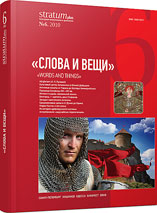Антропонимия «задунайских переселенцев» (последняя треть XVIII — начало XIX вв.)
Anthroponymy of Transdanubian Settlers (1770 — early 1800)
Author(s): Ivan F. GrekSubject(s): History, Anthropology, Social Sciences, Modern Age, Cultural Anthropology / Ethnology, 18th Century, 19th Century
Published by: Издательский дом Stratum, Университет «Высшая антропологическая школа»
Keywords: Bulgarians; Gagauzes; anthroponymy; ethnic history; Dobrogea; Moldova; Bugeac
Summary/Abstract: This paper is the first publication of some archival materials. The author reveals peculiar features of development of anthroponymy among Transdanubian settlers who established in Moldavian Principality and then in Bugeac in 1770 — early 19 th century. He also studies premises for their transformation under the influence of religious factor and conditions of the Ottoman domination, followed by emigration and a long life in a foreign environment. Identity of anthroponyms among the Bulgarians and Gagauzes of Bessarabia does not allow distinguishing them by number of population. Although both linguistic communities were masked under the same name of Bulgarians, this term is not used as an ethnic name, but rather functions as a politonym or toponym. It emerged in 12 th — 14 th cc. in the Second Bulgarian Kingdom, and it was preserved by the bilingual population of the Bulgarian lands during the Ottoman rule. The Turkish-speaking population on the Balkans was not absorbed by the Ottoman Turks owing to their Orthodox faith. In Bugeac, concentration of Turkish-speaking colonists in some localities conditioned the genesis of Gagauz community in Bessarabia.
Journal: Stratum plus. Археология и культурная антропология
- Issue Year: 2010
- Issue No: 6
- Page Range: 289-340
- Page Count: 52
- Language: Russian

